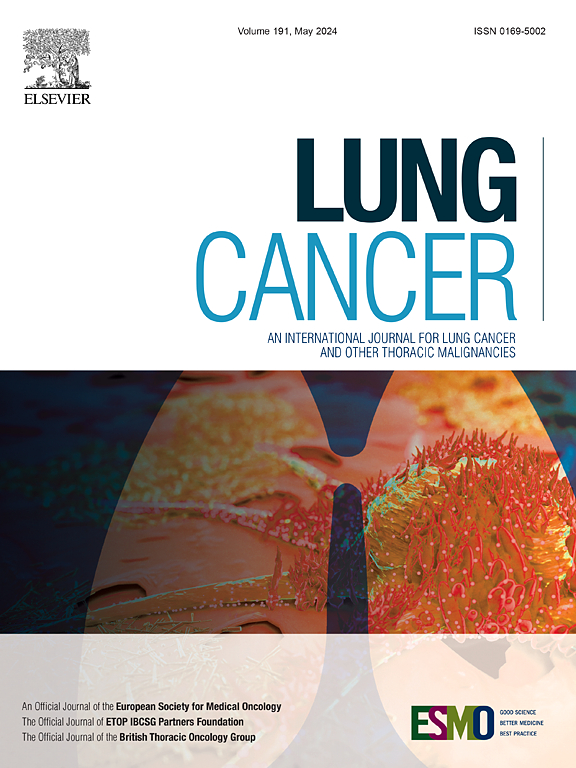原发性肿瘤大小对多灶性T3非小细胞肺癌患者总生存率的影响
IF 4.4
2区 医学
Q1 ONCOLOGY
引用次数: 0
摘要
在非小细胞肺癌(NSCLC)合并T3多灶性疾病(同一肺叶内)的患者中,肿瘤大小对总生存期(OS)的预后意义尚不清楚。在这里,我们评估肿瘤大小对手术和非手术NSCLC中无/有限淋巴结累及(N0/N1)的多灶性T3疾病患者OS的影响。方法:从监测、流行病学和最终结果(SEER)-Medicare数据库中确定年龄≥66岁的新诊断(2010-2015)早期和局部区域晚期NSCLC(根据AJCC第8 /9版,T1-T3, N0/N1, M0),无既往或并发原发癌症的成年人。分析按原发肿瘤大小(≤3cm [T3-small] vs. >.3但≤7cm [T3-large])分层的T3多灶性疾病患者的OS,并与无多灶性疾病(T3-单中心)患者进行比较。结果:在0例接受手术治疗的患者中,t3小病变患者的中位OS(月数[95%可信区间]:86.1[70.2,95.9])优于t3大病变和t3单中心病变患者(月数分别为44.1[36.4,52.7]和51.0[44.6,56.8])。同样,在非手术治疗的N0患者中,t3小病变患者的中位OS(26.7[22.3, 30.7])优于t3大病变和t3单中心病变患者(14.1[12.3,17.2]和10.9[10.0,11.8])。在手术和非手术队列中,患有N1疾病的T3患者在亚组中的生存率相似。结论:在没有淋巴结累及的T3多灶性疾病患者中,肿瘤大小是一个重要的考虑因素,并与OS相关。这些发现可能需要重新评估T3阶段的分类,并为未来TNM分类的演变提供信息。本文章由计算机程序翻译,如有差异,请以英文原文为准。

Implications of primary tumor size on overall survival in patients with multifocal T3 non-small cell lung cancer
Introduction
In patients with non-small cell lung cancer (NSCLC) with T3 multifocal disease (within the same lobe), the prognostic significance of tumor size on overall survival (OS) is unclear. Here, we evaluate the implications of tumor size on OS in patients with multifocal T3 disease without/with limited nodal involvement (N0/N1) in surgical and non-surgical NSCLC.
Methods
Adults aged ≥ 66 years with newly diagnosed (2010–2015) early and locoregionally-advanced NSCLC (T1‒T3, N0/N1, M0 per the AJCC 8th/9th editions), without prior or concurrent primary cancer, were identified from the Surveillance, Epidemiology, and End Results (SEER)-Medicare database. OS in patients with T3 multifocal disease stratified by primary tumor size (≤ 3 cm [T3-small] vs. > 3 but ≤ 7 cm [T3-large]) was analyzed and compared with those without multifocal disease (T3-unicentric).
Results
Among N0 patients who were treated surgically, those with T3-small disease demonstrated improved median OS (months [95% confidence interval]: 86.1 [70.2, 95.9]) vs. those with T3-large and T3-unicentric disease (44.1 [36.4, 52.7] and 51.0 [44.6, 56.8], respectively). Similarly, among the non-surgical N0 patients, those with T3-small disease demonstrated improved median OS (26.7 [22.3, 30.7]) vs. those with T3-large and T3-unicentric disease (14.1 [12.3, 17.2] and 10.9 [10.0, 11.8], respectively). In both surgical and non-surgical cohorts, T3 with N1 disease had similar survival across the subgroups of interest.
Conclusions
In patients with T3 multifocal disease without nodal involvement, tumor size is an essential consideration and associated with OS. These findings may warrant reevaluation of the T3 stage classification and inform the evolution of future TNM classifications.
求助全文
通过发布文献求助,成功后即可免费获取论文全文。
去求助
来源期刊

Lung Cancer
医学-呼吸系统
CiteScore
9.40
自引率
3.80%
发文量
407
审稿时长
25 days
期刊介绍:
Lung Cancer is an international publication covering the clinical, translational and basic science of malignancies of the lung and chest region.Original research articles, early reports, review articles, editorials and correspondence covering the prevention, epidemiology and etiology, basic biology, pathology, clinical assessment, surgery, chemotherapy, radiotherapy, combined treatment modalities, other treatment modalities and outcomes of lung cancer are welcome.
 求助内容:
求助内容: 应助结果提醒方式:
应助结果提醒方式:


